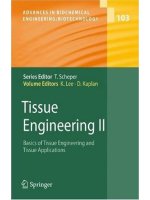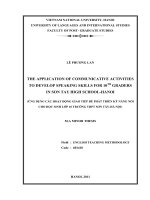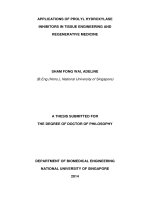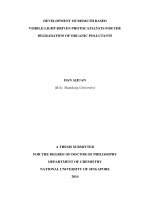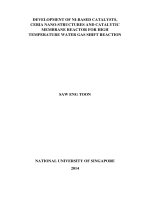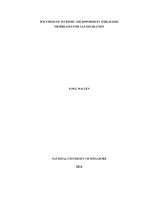Development of chitosan based blend hollow fiber membranes for adsorptive separation in environmental engineering and bioengineering applications
Bạn đang xem bản rút gọn của tài liệu. Xem và tải ngay bản đầy đủ của tài liệu tại đây (2.62 MB, 227 trang )
DEVELOPMENT OF CHITOSAN-BASED BLEND HOLLOW FIBER
MEMBRANES FOR ADSORPTIVE SEPARATION IN
ENVIRONMENTAL ENGINEERING AND BIOENGINEERING
APPLICATIONS
LIU CHUNXIU
NATIONAL UNIVERSITY OF SINGAPORE
2006
DEVELOPMENT OF CHITOSAN-BASED BLEND HOLLOW FIBER
MEMBRANES FOR ADSORPTIVE SEPARATION IN
ENVIRONMENTAL ENGINEERING AND BIOENGINEERING
APPLICATIONS
LIU CHUNXIU
(B.Sc., Nankai University)
A THESIS SUBMITTED FOR THE Ph.D. DEGREE
DEPARTMENT OF CHEMICAL AND BIOMOLECULAR ENGINEERING
NATIONAL UNIVERSITY OF SINGAPORE
2006
ii
Acknowledgement
First and foremost, I would like to thank my supervisor Prof. Bai Renbi for giving me
the chance to join his group and for encouraging me to enter into the wonderful world of
hollow fiber membranes. His continuous support and enthusiasm on this project
encouraged me greatly throughout this work. His integral view on research has made a
deep impression on me and has helped me out immensely by keeping me and my research
focused and on track. I owe him lots of gratitude for having shown me the ways of
scientific research. Besides of being an excellent supervisor, Prof Bai was as close as a
relative and a good friend to all the students. I am really glad that I have come to get know
Prof. Bai in my life.
My next thanks go out to Prof. Neal Chung who had kindly provided help in spinning
and characterizing the hollow fibers membranes. My thanks also go out to all his PhD
students who had helped me a lot throughout the work.
I would like to thank all the students and staffs in particular Li Nan, Han Wei, Liu
Changkun, Wee Kin Ho and Dr. Zhang Xiong who worked in the same lab with me. Over
the past years, I have indeed enjoyed working with them. They are so kind and ready to
help me when necessary. We also discussed and shared some knowledge and information
with each other freely. Best wishes to all of them.
Finally, heartful thanks go to my family for their immense support along the way.
i
Table of Contents
ACKNOWLEDGEMENT I
TABLE OF CONTENTS II
SUMMARY VI
LIST OF TABLES VII
LIST OF FIGURES VII
LIST OF SYMBOLS XV
CHAPTER 1 INTRODUCTION 1
1.1 Background 1
1.2 Hypothesis of this research 7
1.3 Research objectives and scopes of the study 8
CHAPTER 2 LITERATURE REVIEW 12
2.1 Membranes 12
2.2 Membrane materials and preparation methods 14
2.3 Membrane separation processes 19
2.4 Adsorptive membranes 27
2.5 Preparation of adsorptive membranes 31
2.6 Chitosan and its applications in water treatment and bioseparation 34
2.7 Chitosan based flat sheet membranes 38
2.8 Chitosan based hollow fiber membranes 46
2.9 Significance of this study 51
CHAPTER 3 PREPARATION AND CHARACTERIZATION OF
CHITOSAN/CELLULOSE ACETATE (CS/CA) BLEND HOLLOW FIBER
MEMBRANES 53
ii
3.1 Introduction 54
3.2 Experimental 56
3.2.1 Materials 56
3.2.2 Fabrication of CS/CA blend hollow fiber membranes 56
3.2.3 Characterization of hollow fiber membranes 58
3.3 Results and discussion 62
3.3.1 Hollow fiber membranes 62
3.3.2 FTIR analysis of the hollow fiber membranes 63
3.3.3 XRD analysis of the hollow fiber membranes 65
3.3.4 Surface morphology 66
3.3.5 Pure water fluxes (PWF) and contact angles 70
3.3.6 Mechanical property 71
3.3.7 Adsorption performances 72
3.3.7.1 Adsorption of copper ions 72
3.3.7.2 Adsorption of BSA 77
3.3.7.3 Comments on adsorption performance 81
3.4 Conclusions 81
CHAPTER 4 EFFECT OF POLYMER CONCENTRATIONS AND COAGULANT
COMPOSITIONS ON THE STRUCTURES AND MORPHOLOGIES OF THE
CS/CA BLEND HOLLOW FIBER MEMBRANES 83
4.1 Introduction 85
4.2 Experimental 86
4.2.1 Materials 86
4.2.2 Fabrication of CS/CA blend hollow fiber membranes 86
4.2.3 Cloud point study 88
4.2.4 Other analyses of the blend hollow fiber membranes 88
4.3 Results and discussion 89
4.3.1 Cloud point data 89
4.3.2 Effect of cellulose acetate (CA) concentrations 92
4.3.3 Effect of chitosan (CS) concentrations 97
4.3.4 Effect of coagulant compositions 100
4.3.4.1 Effect of external coagulant compositions 101
4.3.4.2 Effect of internal coagulant compositions 104
4.3.5 Mechanical properties of the blend hollow fiber membranes 108
4.4 Conclusions 109
CHAPER 5 ADSORPTIVE REMOVAL OF COPPER IONS WITH CS/CA BLEND
HOLLOW FIBER MEMBRANES 111
5.1 Introduction 112
5.2 Experimental 114
5.2.1 Materials 114
5.2.2 Preparation of CS/CA blend hollow fiber membranes 114
5.2.3 Characterization of CS/CA blend hollow fiber membranes 115
5.2.4 Copper ion adsorption at batch mode 116
iii
5.2.5 Copper ion adsorption at filtration mode 117
5.2.6 Desorption of copper ions and reuse of the hollow fiber membranes 118
5.2.7 Other analyses 118
5.3 Results and discussion 119
5.3.1 Characteristics of the CS/CA blend hollow fiber membranes 119
5.3.2 Copper ion adsorption amount 122
5.3.3 Copper ion adsorption isotherm 122
5.3.4 Adsorption kinetics 124
5.3.5 Copper ion adsorption at low copper ion concentrations 128
5.3.6 Adsorption mechanism 130
5.3.7 Desorption and reuse 133
5.3.8 Elution of copper ion solution using 3-12-OH membrane 135
5.4 Conclusions 136
CHAPTER 6 COPPER IONS COUPLED CS/CA BLEND HOLLOW FIBER
MEMBRANES FOR AFFINITY-BASED ADSORPTION OF BOVINE SERUM
ALBUMIN PROTEINS 137
6.1 Introduction 138
6.2 Experimental 140
6.2.1 Materials 140
6.2.2 Coupling with copper ion ligand 140
6.2.3 Washing the membrane coupled with copper ion ligand 140
6.2.4 BSA adsorption 141
6.2.5 Leakage of copper ions during BSA adsorption 142
6.3 Results and discussion 142
6.3.1 Amount of copper ion ligands coupled 142
6.3.2 Nonspecific and specific binding of BSA 145
6.3.3 Copper ion ligand utilization 146
6.3.4 Adsorption isotherms 147
6.3.5 Effect of solution pH on BSA binding 148
6.3.6 Effect of ionic strength on BSA binding 150
6.3.7 BSA binding kinetics 152
6.3.8 Copper ion leakage 153
6.4 Conclusions 157
CHAPTER 7 SURFACE MODIFICATION OF CS/CA BLEND HOLLOW FIBER
MEMBRANES WITH CIBACRON BLUE F3GA DYE FOR IMPROVED
ADSORPTION PERFORMANCE IN HEAVY METAL ION REMOVAL 158
7.1 Introduction 159
7.2 Experimental 161
7.2.1 Materials 161
7.2.2 Coupling of CB dye onto CS/CA blend hollow fiber membrane 161
7.2.3 Characterization of the hollow fiber membranes 162
7.2.4 Adsorption studies 163
7.2.5 Regeneration and reuse of the hollow fiber membranes 164
iv
7.2.6 Competitive adsorption 165
7.3 Results and discussion 165
7.3.1 FTIR and XPS analysis 165
7.3.2 Dye coupling amount 168
7.3.3 Zeta potentials 169
7.3.4 Copper ion adsorption capacity 171
7.3.5 Adsorption isotherms 172
7.3.6 Adsorption kinetics 174
7.3.7 Effect of pH on adsorption capacity 175
7.3.8 Regeneration and reuse of the dyed hollow fiber membranes 176
7.3.9 Competitive adsorption 177
7.4 Conclusions 178
CHAPTER 8 CONCLUSIONS AND RECOMMENDATIONS FOR FUTURE
WORK 180
8.1 Conclusions 180
8.2 Recommendations for future work 182
REFERENCES 187
v
Summary
Adsorptive separation using surface functionalized microfiltration membrane has been
being increasingly studied in recent years in environmental and bio- engineering fields to
selectively separate heavy metal ions and biomolecules. In this project, a novel adsorptive
hollow fiber membrane, chitosan/cellulose acetate (CS/CA) blend hollow fiber membrane
was prepared wherein CS provides functional groups (-NH
2
) while CA acts as hydrophilic
support. Protic solvents (>60%v/v) were able to dissolve two polymer together. The
coagulant used for spinning the hollow fiber membranes was water or NaOH solution. The
research scope of this study includes (1) membrane preparation method study, (2)
examination of effect of spinning parameter on membrane structure, (3) application of the
membranes for heavy metal ion removal and binding of BSA, and (4) modification the
membranes. It was found that the two polymers were miscible in the blends. By adjusting
the polymer concentration in spinning solution and composition of coagulant, a variety of
CS/CA blend hollow fiber membranes with outer surface pore size in range of
~49nm-0.54µm were prepared. The blend hollow fiber membrane can be prepared to have
sponge-like and macrovoids-free cross-sectional structure that is desirable for adsorptive
filtration. The maximum CS content in the blend membrane that was achieved in this
project was 120 mg/g. At batch mode of adsorption, maximum adsorption capacity for
Cu
2+
was 12.5mg/g and that for BSA after coupling the membrane with Cu
2+
ligand was
60mg/g. Surface modification with CB F3GA dye improved the kinetics, adsorption
amount at low concentration and low pH as well as regeneration by using HCl as
desorbent of the original blend hollow fiber membrane for copper ion adsorption.
vi
List of Tables
Table 2.1 Water contact angle θ (°) for some common membrane materials 15
Table 2.2 Development of membrane processes (Adopted form reference [12]) 19
Table 2.3 Applications of membrane separation processes 20
Table 2.4 Membrane separation mechanisms 22
Table 2.5 Driving force applied in membrane separation process 22
Table 2.6 Characteristics of membrane separation processes for water treatment [12, 26-30]
23
Table 2.7 Blending materials reported in literature and characteristics of the blend
membranes or films 41
Table 3.1 Dope compositions and other information for the Pure CA hollow fibers and
CS/CA blend hollow fibers 0.5-26.5-OH and 1-26-OH 62
Table 3.2 Crystallinity and peak diffraction angles of CS and Pure CA hollow fiber
membrane and CS/CA blend hollow fiber membranes 0.5-26.5-OH and 1-26-OH 66
Table 3.3 Pure water fluxes and water contact angles of CS and Pure CA hollow fiber
membranes and CS/CA blend hollow fiber membranes 0.5-26.5-OH and 1-26-OH .70
Table 3.4 Mechanical test results for Pure CA hollow fiber membranes and CS/CA blend
hollow fiber membranes 0.5-26.5-OH and 1-26-OH 71
Table 3.5 Internal surface areas and CS contents on the Pure CA hollow fiber membranes
and CS/CA blend hollow fiber membranes 0.5-26.5-OH and 1-26-OH 72
Table 3.6 Experimental adsorption amounts of copper ions on Pure CA hollow fiber
membranes and CS/CA blend hollow fiber membranes 0.5-26.5-OH and 1-26-OH .74
vii
Table 3.7 Reuse of CS/CA blend hollow fiber membranes 1-26-OH for copper ions
adsorption 77
Table 3.8 Experimental adsorption amounts of BSA on Pure CA hollow fiber membranes
and CS/CA blend hollow fiber membranes 0.5-26.5-OH and 1-26-OH 78
Table 3.9 Reuse of CS/CA blend hollow fiber membranes 1-26-OH for BSA adsorption 81
Table 4.1 Parameters investigated for spinning CS/CA blend hollow fiber membranes 87
Table 4.2 Cloud point data of different spinning solution compositions at 25ºC 89
Table 4.3 Effect of external coagulant composition on the structural characteristics of the
CS/CA blend hollow fiber membranes 104
Table 4.4 Effect of internal coagulant composition and CS concentration on the structural
characteristics of the CS/CA blend hollow fiber membranes 108
Table 4.5 Mechanical test results for some of the CS/CA blend hollow fiber membranes
prepared at CS/CA/FA weight ratio of 2.0/12.0/86.0 and 2.0/13.0/85.0 in the spinning
solutions 109
Table 5.1 Information on the CS/CA blend hollow fiber membranes prepared for copper
ion adsorptions 115
Table 5.2 XPS C 1s, O 1s and N 1s binding energies of the CS/CA blend hollow fiber
membranes before and after copper ion adsorption 131
Table 5.3 Desorption of copper ions from CS/CA blend hollow fiber membranes 3-12-OH
using EDTA and HCl solutions as the desorbents 133
Table 5.4 Reuse of the CS/CA blend hollow fiber membranes 3-12-OH for copper ion
adsorption 134
Table 6.1 Comparison of copper ions immobilized in literatures 143
viii
Table 7.1 CB F3GA dye coupling amounts for different materials attempted by various
researchers 169
Table 7.2 Amount of copper ions adsorbed on dyed hollow fiber membranes for different
cycles using 50mM HCl and 50mM EDTA as the desorbents 177
Table 7.3 Competitive adsorption capacities of different metal ions for dyed and undyed
hollow fiber membranes 178
ix
List of Figures
Figure 1.1 Solute transports in packed bed (top) and adsorptive membrane (bottom)
(Adopted from reference [3]) 5
Figure 2.1 Schematic illustration of the cross-sections of symmetric and asymmetric
membranes (Adopted from reference [12]) 12
Figure 2.2 Schematic illustrations of adsorptive membrane cartridges (Adopted from
reference [31]) 30
Figure 2.3 Schematic chemical structures of (1) chitin, (2) chitosan and (3) cellulose 34
Figure 3.1 Schematic chemical structure of cellulose acetate 54
Figure 3.2 Schematic diagram of the experimental setup for hollow fiber membrane
fabrication 57
Figure 3.3 FTIR spectra of CS and Pure CA hollow fiber membranes and CS/CA blend
hollow fiber membranes 0.5-26.5-OH and 1-26-OH 64
Figure 3.4 XRD diffractograms of CS and Pure CA hollow fiber membranes and CS/CA
blend hollow fiber membranes 0.5-26.5-OH and 1-26-OH 65
Figure 3.5 Cross-sectional morphologies of Pure CA hollow fiber membranes and CS/CA
blend hollow fiber membranes 1-26-OH 67
Figure 3.6 Outer and inner surface morphologies of Pure CA hollow fiber membranes and
CS/CA blend hollow fiber membranes 1-26-OH 68
Figure 3.7 Isotherm adsorption data of copper ions on CS/CA blend hollow fiber
membranes 1-26-OH and data fitting with the Langmuir and Freundlich isotherm
models 76
x
Figure 3.8 Isotherm adsorption data of BSA on CS/CA blend hollow fiber membranes
1-26-OH and data fitting with the Langmuir and Freundlich isotherm models 80
Figure 4.1 Effect of CA concentrations in the spinning solutions on the overall and
cross-sectional structures of the CS/CA blend hollow fiber membranes 92
Figure 4.2 Effect of CA concentrations in the spinning solutions on the structural
characteristics of the CS/CA blend hollow fiber membranes 94
Figure 4.3 Effect of CA concentrations in the spinning solutions on the outer surface
morphologies of the CS/CA blend hollow fiber membranes 96
Figure 4.4 Effect of CA concentrations in the spinning solutions on the inner surface
morphologies of the CS/CA blend hollow fiber membranes 96
Figure 4.5 Effect of CS concentrations in the spinning solutions on the outer surface
morphologies of the CS/CA blend hollow fiber membranes 97
Figure 4.6 Effect of CS concentrations in the spinning solutions on the structural
characteristics of the CS/CA blend hollow fiber membranes 99
Figure 4.7 Overall view of the CS/CA blend hollow fiber membrane 2-12-OH/w 102
Figure 4.8 Effect of external coagulant composition on the outer surface morphologies of
the CS/CA blend hollow fiber membranes 103
Figure 4.9 Effect of internal coagulant composition on the cross-sectional structures of the
CS/CA blend hollow fiber membranes 104
Figure 4.10 Effect of internal coagulant composition on the inner edge structures of the
CS/CA blend hollow fiber membranes 106
Figure 4.11 Effect of internal coagulant composition and CS concentration on the inner
surface morphologies of the CS/CA blend hollow fiber membranes 107
xi
Figure 5.1 Morphologies of CS/CA hollow fiber membranes for copper ion adsorptions
121
Figure 5.2 Equilibrium copper ion adsorption amounts on the CS/CA blend hollow fiber
membranes versus C
e
122
Figure 5.3 Correlating copper ion adsorption on 3-12-OH CS/CA blend hollow fiber
membranes with Langmuir isotherm model 123
Figure 5.4 Correlating copper ion adsorption on the 3-12-OH CS/CA blend hollow fiber
membranes with Freundlich isotherm model 124
Figure 5.5 Comparison of the experimental adsorption results of copper ion adsorption on
3-12-OH CS/CA blend hollow fiber membranes with the fitted results from the
Langmuir and Freundlich models 124
Figure 5.6 Adsorption kinetics of copper ions on the CS/CA blend hollow fiber
membranes 3-12-w and 3-12-OH 125
Figure 5.7 Correlating the copper ion adsorption kinetics on CS/CA blend hollow fiber
membranes 3-12-OH with pseudo first-order (a) and pseudo second-order (b) kinetics
models 128
Figure 5.8 Copper ion adsorption at low concentrations (C
0
= 0.28-6.5 mg/L) using the
hollow fiber membranes 3-12-OH, showing the equilibrium copper ion
concentrations (C
e
) versus the initial copper ion concentrations (C
0
) in the bulk
solution 129
Figure 5.9 Typical N 1s XPS spectra of the CS/CA hollow fiber membranes 3-12-OH
before (a) and after (b) copper ion adsorption 132
Figure 5.10 Copper ion elution profile using 3-12-OH CS/CA blend hollow fiber
membrane 135
xii
Figure 6.1 Adsorption of BSA on CS/CA and CS/CA-Cu blend hollow fiber membranes
145
Figure 6.2 Correlation of BSA adsorption on the CS/CA-Cu blend hollow fiber
membranes with the Langmuir isotherm model (a) and the Freundlich isotherm
model (b) 148
Figure 6.3 Effect of solution pH on BSA binding amounts on the CS/CA-Cu blend hollow
fiber membranes. NaCl concentration was 120 mM 149
Figure 6.4 Effect of ionic strength (NaCl concentration) on the BSA bindings on the
CS/CA and CS/CA-Cu blend hollow fiber membranes. Solution pH was 7.4 151
Figure 6.5 Change of BSA concentrations (C) in the bulk solution with adsorption time (t)
with the CS/CA-Cu hollow fiber membranes as the adsorbent 152
Figure 6.6 Correlating the BSA adsorption kinetic data on the CS/CA-Cu blend hollow
fiber membranes with the pseudo first-order (a) and pseudo second-order (b) kinetics
models 153
Figure 6.7 Copper ion leakages from CS/CA-Cu hollow fiber membranes during BSA
adsorption 155
Figure 6.8 Correlation of the copper ion leakages from the CS/CA-Cu blend hollow fiber
membranes with the Freundlich (a) and Langmuir (b) isotherm models 156
Figure 7.1 Schematic chemical structure of Cibacron Blue F3GA 160
Figure 7.2 Schematic illustration of reaction between CB dye and CS/CA hollow fiber
membrane 162
Figure 7.3 FTIR spectra for CB F3GA dye and CS/CA blend hollow fiber membranes
before and after CB F3GA dye coupling 166
Figure 7.4 Nuleophilic reaction mechanisms between CS/CA membrane and CB dye 167
xiii
Figure 7.5 XPS spectra for CB F3GA dye and CS/CA blend hollow fiber membranes
before (a) and after (b) CB F3GA dye coupling 168
Figure 7.6 Zeta potentials for undyed and dyed CS/CA blend hollow fiber membranes.170
Figure 7.7 Equilibrium copper ion adsorption amount for undyed and dyed CS/CA blend
hollow fiber membranes 171
Figure 7.8 Correlating copper ion adsorption on dyed CS/CA blend hollow fiber
membrane with Langmuir isotherm model 173
Figure 7.9 Correlating copper ion adsorption on dyed CS/CA blend hollow fiber
membrane with Freundlich isotherm model 173
Figure 7.10 Comparison of the experimental adsorption results of copper ion adsorption
on dyed CS/CA blend hollow fiber membranes with the fitted results from the
Langmuir and Freundlich models 173
Figure 7.11 Copper ion adsorption kinetics on the dyed and undyed CS/CA blend hollow
fiber membranes 175
Figure 7.12 Effect of solution pH on copper ion adsorption on the dyed and undyed
CS/CA blend hollow fiber membranes 176
Figure 8.1 Schematic illustrations of two filtration modes for adsorptive membrane 185
xiv
List of Symbols
1/n
Freundlich intensity parameter (dimensionless)
b
the adsorption equilibrium constant in Langmuir isotherm model
(L/mg)
BE binding energy (ev)
BFFR bore fluid flow rate
BSA Bovine Serun Albumin
C
concentration of solutes in the bulk solution
C
0
initial concentration of solute in the bulk solution (mg/L)
CA cellulose acetate
CB Cibacron Blue F3GA
C
e
equilibrium concentration of solute in the bulk solution (mg/L)
CS chitosan
CS/CA chitosan/cellulose acetate blend hollow fiber membranes
CS/CA-Cu copper ion immobilized CS/CA blend hollow fiber membranes
D dialysis
DDA degree of N-deacetylation
DER dope extrusion rate
ED electrodialysis
ELM emulsion liquid membrane
FA 98-100% formic acid
GS gas separation
I.D. inner diameter
IMA immobilized metal ion affinity
xv
IMAC immobilized metal ion affinity chromatography
IMAMs immobilized metal ion affinity membranes
K
1
rate constant of pseudo first-order kinetics model (min
-1
or hr
-1
)
K
2
rate constant of pseudo second-order kinetics model (g · mg
-1
· min
-1
or
g · mg
-1
· hr
-1
)
k
d
intrinsic kinetic rate constant for diffusion-controlled adsorption
(mg · g
-1
· min
-0.5
)
K
f
Henry’s law constant in Freundlich isotherm model (mg/g)/(mg/L)
n
LM liquid membrane
MF microfiltration
MW molecular weight
MWCO molecular weight cut off
NF nanofiltration
O.D. outer diameter
PAN polyacrylonitrile
PE polyehtylene
PES polyethersulfone
PP polypropylene
PSF polysulfone
PTFE polytetrafluoroethylene
PV pervaporation
PVC polyvinylchloride
PVDF polyvinylidene difluoride
PWF pure water fluxes
q
e
equilibrium adsorption amount (mg/g)
q
m
the maximum adsorption amount in Langmuir isotherm model (mg/g)
q
t
the adsorption amount at time t (mg/g)
R
2
linear regression coefficients
xvi
RO reverse osmosis
rpm rounds per minute
SLM supported liquid membrane
t
adsorption time (min or hr)
UF ultrafiltration
xvii
Chapter 1 Introduction
1.1 Background
The development and application of membrane separation processes is one of the most
significant advances in chemical, environmental, and biological process engineering.
Currently, membrane process has been successfully applied in gas separation, desalination,
water treatment, purification of biopharmaceutical products and food/beverages, and
kidney dialysis, etc. Membrane separation system enjoys numerous advantages over
conventional separation methods (such as coagulation plus deep bed filtration, distillation,
extraction, ion exchange, and so on) including energy saving, environmentally benign,
clean technology with operational ease, high quality products, and great flexibility in
system design [1].
One of the most common applications for the membrane separation process is for
water treatment to remove, concentrate or separate various components with different
sizes or dimensions, such as particles, colloids, bacteria, viruses, proteins, humic matters,
organic compounds, soluble salts, heavy metal ions, detergents, and so on. Among these
components, salts or metal ions are more difficult to remove due to their smaller size
(0.3-0.6nm). Among the metal ions, heavy metal ions such as Hg
2+
, Cd
2+
, and Cu
2+
and so
on are highly toxic to human bodies even at very low concentration (mg/L). Therefore,
removal of them is more crucial. Some of the conventional membrane separation
processes such as microfiltration (MF) and ultrafiltration (UF) cannot remove them
because of the relatively larger pore sizes of the membrane (>50nm). In contrast,
nanofiltration (NF) and reverse osmosis (RO) processes are able to reject them effectively
1
due to the smaller pore size (NF: ≈1nm, RO: 0.1-1nm). NF is able to retain multi-valent
ions such as Ca
2+
, Mg
2+
and toxic heavy metal ions. RO is able to retain monovalent ions
such as Na
+
and K
+
. However, NF/RO processes are generally not economical because of
the high operating pressures (5-80bar) and low permeate fluxes (1L membrane has pure
water flux at only 70-170mL/min). Other membrane processes such as electrodialysis (ED)
and liquid membranes (LM) are also effective in removal or concentration of heavy metal
ions. However, ED process has low water permeate flux and is only used in a small scale
because only flat membrane is adopted in ED process. Liquid membrane process is a
sorption-diffusion process. It has low processing rate as solute transport is controlled by
diffusion. Moreover, instability of liquid and loss of carrier from membrane support is
severe and limits the wide application of this process.
It is always desirable to be able to remove heavy metal ions with membranes of larger
pores (hence high permeate fluxes and low energy consumption), but to achieve high
removal efficiency and high selectivity. This may be accomplished by using microporous
adsorptive membranes that separate the desired or undesired substances from solutions
through affinity adsorption, rather than size exclusion, sorption-diffusion, or ion exchange
principles. When the feed is made to pass through the membrane thickness, the desired
components to be removed or separated will interact with the functional groups on the
external and internal surfaces while the liquid or other components that have low affinity
with the membranes will pass through the membrane freely. When the membranes reach
adsorption saturation, the adsorbed components can be washed off from the membranes
with some types of desorbents and the membranes can then be reused.
2
Another important application of membrane filtration technology is to harvest and
fractionate proteins, enzymes, microbial cells in pharmaceutical industry or to separate
bio-products in bioengineering. The membrane processes used for this purpose are mainly
UF membranes and dialysis membranes. However, these membrane processes are also
based on size exclusion or sieving mechanism. They usually have low selectivity towards
components having similar molecule weights and sizes. An alternative way to extract or
separate the desired components can be usage of adsorptive membranes. Adsorption based
membrane filtration has been developed since 1988 and now it has become a mature and
commercial technology: membrane chromatography. The high selectivity of membrane
chromatography is often achieved by coupling of specific affinity ligands, such as dyes,
bioligands, and metal ions etc., onto the membrane surfaces. When a protein mixture
solution passes through the membranes, only the components that have specific affinity
with the ligands will be retained on the membrane surface.
Adsorptive membranes may be considered as a special type of MF membranes. The
major difference between them is that adsorptive membrane bears functional groups or
specific ligands on surface. The choice of MF type of membrane as adsorptive membrane
substrate is based on the consideration that it can provide not only high permeate fluxes at
low energy consumption but also high internal specific surface areas for binding more
components. The greater pore sizes of MF type of membrane also allow the free passage
of large biomacromolecules into the membranes so that the adsorption separation can fully
take place in the interior of the membranes. Selective separation can be achieved by
coupling different functional groups on the membrane.
3
The separation mechanism of adsorptive membranes is essentially same as that of
adsorptive beads or resins since both configurations remove or concentrate the targets by
binding them on the surfaces of a solid. However, the membrane based configurations are
more efficient than the beads or resins by providing high processing rate. It is well known
that the beads or resins are usually packed into a column in practice. When the feed is
made to pass though the interstices of the resins in the column, the solutes in the flowing
solution have to diffuse a long distance to travel to internal binding sites on the resins for
separation to fully take place. Therefore, the processing rate of the resin packed column is
very low. In the membrane based configuration, however, the solutes are brought to the
external and internal binding sites of the membranes mainly by faster convective flow
rather than molecular diffusions, and therefore higher processing rates can be achieved [2].
Schematic illustration of the solute transports in a packed bed and an adsorptive
membrane is shown in Fig. 1.1. The fast processing capability of adsorptive membranes is
of great importance to the industry for design of fast but low cost separation processes. In
the separation of bioproducts, the fast processing rate and low operation pressure
requirement is more important because it can minimize the denaturization of fragile
proteins.
4
Membrane wall
Membrane internal pore
Figure 1.1 Solute transports in packed bed (top) and adsorptive membrane (bottom)
(Adopted from reference [3])
Currently, the major method for preparing adsorptive membrane is by surface
modifications of the existing commercial membranes which are usually fabricated from
synthetic polymers such as polysulfone (PSF), polyethersulfone (PES), polyvinylidene
5
difluoride (PVDF), polyethylene (PE), polypropylene (PP), polyamide (nylon), etc. These
membranes are chemically inert and highly hydrophobic, usually resulting in low binding
capacity and high nonspecific binding or low separation selectivity. Therefore, these
conventional membranes need to be surface modified by the introduction of hydrophilic
and reactive functional groups, such as -OH, -NH
2
, -N
+
R
3
, -COOH, -SO
3
H, epoxy and so
on, to the surfaces to eliminate the nonspecific adsorption, increase the binding capacity,
or facilitate other ligands coupling. The surface modification methods usually involve
graft polymerization on the surfaces. However, the modifications are often conducted
under harsh physical and chemical conditions, such as through oxidation with ozone,
exposure to an electron or ion-beam, through ultrasonic etching, UV or laser irradiation
[4-6], or by plasma treatment at low or ambient pressure [7-8], which often cause damages
to the membranes structures and result in severe degradation of the polymer chains [9].
An alternative method to prepare adsorptive membranes is to use naturally occurring
biopolymers or their derivatives that contain functional groups on the polymer backbones
as the adsorptive membrane materials. The process to prepare adsorptive membranes is
hence greatly simplified because surface modifications of the membranes made from these
materials are much easier or even unnecessary. Moreover, the naturally occurring
biopolymers have many other advantages over the synthetic polymers, including high
hydrophilicity, good biocompatibility, nontoxicibility, low cost, and renewability, etc.
Among the biopolymers used, cellulose has been the most widely studied polymer for
the preparation of adsorptive membranes. The reactivity of cellulose comes from the
hydroxyl groups (-OH) on the polymer backbones. However, -OH does not show direct
binding capability to heavy metal ions or proteins. It needs further derivation with other
6


